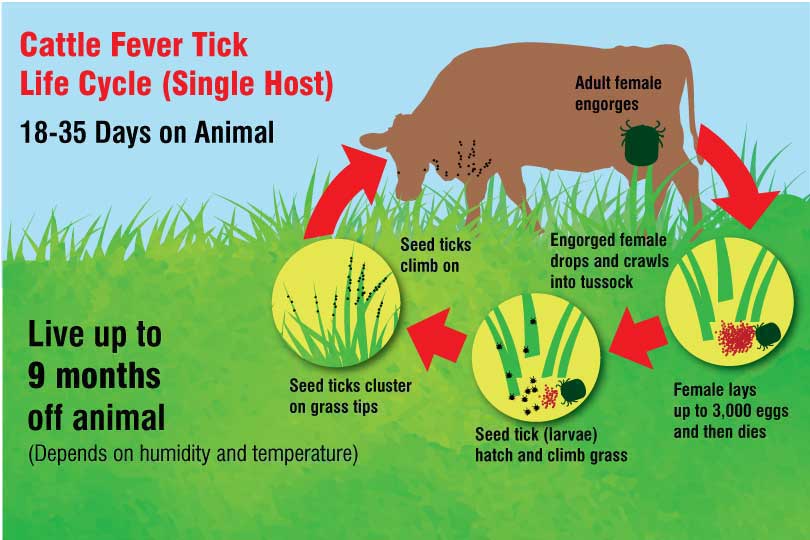By Julie Tomascik
Editor
Cattle treatment protocols are the focus of the Texas Department of Agriculture’s (TDA) rule proposal for the fever tick eradication program.
TDA’s proposed rule creates additional regulatory language for the application of flowable 42% Co-Ral, a pesticide containing coumaphos, according to a letter Texas Farm Bureau (TFB) submitted to the agency last month.
The pesticide is authorized for use in the Texas Cattle Fever Tick Eradication Program by certified applicators when using portable spray- dip machines or dipping vats.
TFB’s letter outlined strong opposition to the repetitive label restrictions regarding pesticide application and requested withdrawal of the proposal.
“The Co-Ral product label states that it is only available for sale and use by certified applicators and persons under their direct supervision. It goes a step further and requires employee applicators to enroll in a cholinesterase monitoring program that allows for direct evaluation of exposure,” Tracy Tomascik, TFB associate director of Commodity and Regulatory Activities, wrote. “Finally, under the “application restrictions” section of the product label is the statement ‘Do not spray in confined, non-ventilated areas.’”
The spray-dip machines have proven to be an effective tool for regulators and preferred option for ranchers, according to the Texas Animal Health Commission (TAHC).
“Treating cattle with Co-Ral in spray-dip machines is a proven, safe method of eliminating cattle fever ticks, second only to dipping in efficacy,” Tomascik wrote. “The vast majority of cattle owners involved in the fever tick quarantines welcome the option of spray-dip machine treatment, as it provides an alternative to hauling cattle to a dipping vat.”
The specially-formulated product used in the spray-dip machines is only available for use by trained regulatory employees and must be applied to the entire animal to ensure a fever tick doesn’t evade contact with the insecticide.
The spray-dip machines use high pressure nozzles inside an enclosed cattle chute with a feature that captures and recirculates all excess product, has proper ventilation and prevents environmental contamination.
The spray-dip machines are mobile units, allowing officials to take the treatment to the ranch and have been in use for decades. In the last four years, state and federal regulators have used the spray boxes to safely and effectively treat more than 60,000 head of cattle.
“We believe that TAHC and USDA-APHIS personnel correctly interpret the label to apply only to applicators,” Tomascik said. “Co-Ral Flowable Insecticide has been, and continues to be, used to treat cattle in spray-dip machines according to label directions and these treatment protocols.”
Cattle fever ticks have the potential to carry and transmit the disease bovine babesiosis, which destroys red blood cells and results in anemia, fever, illness and death in up to 90 percent of infected cattle.
Outbreaks across the southern part of Texas have driven stakeholders to take notice and act to suppress the ticks’ spread, Tomascik said.
With cooperation among all parties, Tomascik noted the eradication program continues to show success, and numerous counties have been released from temporary quarantine.


As a member I am very disappointed that you would agree to minimize the regulations surrounding the handling of such toxic chemicals and think that “all the cattle farmers” are gong to handle this product as intended. How are they going to dispose of the excess. Dump it in the creek, or out on the pasture. I witness this mis use of toxic chemicals on a daily basis and am frustrated with everyone thinking the majority of the Farmers will handle this properly.
Hi Kelly – ranchers do not have access to this product and it already has extensive restrictions for use. It’s only available to the fever tick eradication program agencies and they follow strict disposal protocols. Environmental contamination is a high concern for everyone. Especially the ranchers that own that land.
Texas stockmen deserve and should demand a more modern approach to ridding infestations of Cattle Fever Ticks. Integrative pest management strategies to include the vaccination of cattle against Babesia and cattle fever tick, pasture treatment and the use of macrocyclic lactone injectables (which are proven to rid cattle of ticks) could easily replace the hundred -year-old technology of dipping and sprayboxing cattle. (You can call the spray box a spray-dip machine all day – it still is being used in a closed ventilation environment). What is holding up the progress is the multi-million dollar budget of the USDA CFTEP which has sustained itself over decades by the use of antiquated technology. There are proven chemicals for use on pastures infested with similar foreign ticks. Why are they not used in Texas? Because the USDA and the TAHC have too much to lose in the way of agency funding if the threat of cattle fever ticks goes away! For the TFB to support antiquated techniques which are dangerous to the naive applicator is a testament to how TFB is complicit with USDA in the world of quid pro quo politics. Texas stockmen should demand better leaders in protecting Texas animal agriculture. We can do better than reliance on techniques developed in the early 20th century, when the science of parasite control has been revolutionized in the last 35 years.
Texas farm bureau is supportive of all eradication program options and especially the ones you mention above. Vaccination, endectocides, pasture treatment are all part of a successful program. What pasture treatments are you writing about? Similar ticks doesn’t automatically equate to effectiveness.
TFB has been a leading voice to upgrade the program and develop new tools. Such things require funding and the organization’s support and efforts have helped make that possible.
There’s a lot of work going on among the agencies you mentioned to keep cattle safe and ranchers in business. If eradication was that easy, it would be finished by now.